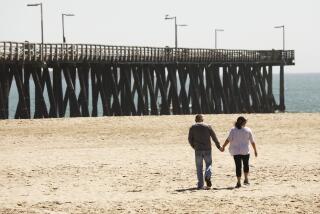Home Sales Halted Pending Vapor Tests
- Share via
MANHATTAN BEACH — Sales of town homes and condominiums at the Manhattan Village residential complex have been halted by the developer while scientists attempt to determine the extent and severity of near-explosive levels of methane recently discovered there.
Meanwhile, Chevron USA Inc. officials have unveiled plans for a vapor recovery system that they say could rid the El Porto area of hydrocarbon vapors by this fall.
The vapor problems in both areas were discovered as a result of testing that began in January, when Chevron officials disclosed that a large pool of liquid hydrocarbons had leaked off its El Segundo refinery into that city’s manufacturing district. Later testing revealed potentially explosive levels of the gasoline-based vapors along The Strand in El Porto as well.
When those vapors were discovered, officials at Chevron USA’s sister company, Chevron Land and Development Co., decided to retest its Manhattan Village project for possible vapor migration. Until the mid-1960s, that land held football-field-size concrete reservoirs that the refinery used to store heavy crude and other fuel oils. It is now the site of the Manhattan Village Mall and more than 160 homes.
Chevron Land spokesman Gary Luque said that while the company had tentative buyers lined up for more than a third of the 42 homes still under construction, Chevron has opted to delay sales until the results of further testing are known. Sales also will be stalled on another 17 homes that have been completed but not yet sold. Homes in this phase of the project, he said, range in price from $200,000 to $300,000.
Question of Liability
“We want potential home buyers to have full knowledge before they purchase a home,” Luque said. “And there also is a question of liability. I think we (Chevron Land) need to have full knowledge before we sell any more homes.”
Another 390 units of residential housing are scheduled for completion by next year, as are an office park, medical building, hotel and recreational facilities. Luque said construction of those facilities should not be delayed by the testing.
The tests were begun in mid-February to assuage the fears of owners and tenants in the area that gasoline-based hydrocarbon vapors discovered in El Porto last month had migrated farther south to Manhattan Village. The results showed no hydrocarbon vapors. But they did reveal methane at levels of 51,000 parts per million 50 feet below the surface in the middle of the golf course, about two blocks from occupied homes. Methane becomes explosive at 53,000 ppm.
According to state Department of Health Services spokesman Jim Smith, the chief danger at those levels is from fire, explosion or asphyxiation should the fumes leak into a confined building. However, he noted, there is no immediate danger to residents in the area.
Traces of Fuel Oil
While the methane has not been traced directly to petroleum products that may still be underground, Luque said testing has shown traces of fuel oil in the samples taken.
More extensive testing will begin Monday, he said, when independent consultants for the company are scheduled to sink a number of wells to measure vapors and monitor ground water in the area. The Manhattan Village project sits atop a deep underground aquifer that supplies about 15% of the city’s drinking water.
Meanwhile, officials from Chevron USA earlier this week unveiled their plans to mitigate potentially explosive levels of hydrocarbon vapors discovered in El Porto last month.
The plan, according to Chevron lead design engineer Don Means, consists of installing a series of vapor recovery wells about 100 feet apart along The Strand in El Porto, where the highest levels of vapors have been found.
Using this system, which would suck vapors from the ground and incinerate them at a station on the refinery’s property, Means said the vapors could be brought below the explosive level in as little as three weeks, and should subside to “negligible levels” within two months.
By Mid-July
Pending approval from various government and regulatory agencies, he said, construction of the system could begin as early as June 24 and the system itself could be operating by mid-July.
Manhattan Beach Public Services Director Carl Abel said the city “basically sees no problems” with the plan, although the City Council has not yet voted on it.
“Our main concern is that nothing stand in the way of getting rid of those vapors,” Abel said after Chevron’s presentation to the city on Tuesday. “Bureaucracy is not going to be allowed to interfere with this operation.”
More to Read
Inside the business of entertainment
The Wide Shot brings you news, analysis and insights on everything from streaming wars to production — and what it all means for the future.
You may occasionally receive promotional content from the Los Angeles Times.










